
The following is a timeline of the history of the city of Anchorage, Alaska, United States.

The following is a timeline of the history of the city of Anchorage, Alaska, United States.
| Part of a series on the |
| History of Alaska |
|---|
 |
|

Alaska is a non-contiguous U.S. state on the northwest extremity of North America. It is in the Western United States region. The only other non-contiguous U.S. state is Hawaii. Alaska is also considered to be the northernmost, westernmost, and easternmost state in the United States. It borders the Canadian territory of Yukon and the province of British Columbia to the east. It shares a western maritime border, in the Bering Strait, with Russia's Chukotka Autonomous Okrug. The Chukchi and Beaufort Seas of the Arctic Ocean lie to the north, and the Pacific Ocean lies to the south. Technically a semi-exclave of the U.S., it is the largest exclave in the world.

Kenai is a city in the Kenai Peninsula Borough in the U.S. state of Alaska. By road, it is 158 miles southwest of Anchorage. The population was 7,424 as of the 2020 census, up from 7,100 in 2010, the fifteenth-most populated city in the state.

Eklutna is a native village within the Municipality of Anchorage in the U.S. state of Alaska. The Tribal Council estimates the population at 70; many tribal members live in the surrounding communities.

The University of Alaska Anchorage (UAA) is a public university in Anchorage, Alaska. UAA also administers four community campuses spread across Southcentral Alaska: Kenai Peninsula College, Kodiak College, Matanuska–Susitna College, and Prince William Sound College. Between the community campuses and the main Anchorage campus, roughly 15,000 undergraduate, graduate, and professional students are currently enrolled at UAA. It is Alaska's largest institution of higher learning and the largest university in the University of Alaska System.
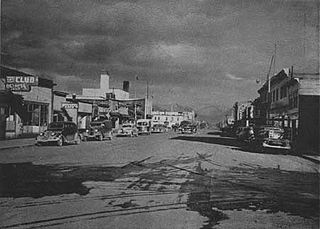
After congress approved the completion of the Alaska Railroad from Seward to Fairbanks in 1914, it was decided that a new town should be built as a port and rail hub along the route. The decision was made to develop a site near Ship Creek on Cook Inlet. Survey parties visited the area in 1914 and researched possible routes for the rails and options for siting the new town. Anchorage was originally settled as a tent city near the mouth of Ship Creek in 1915, and a planned townsite was platted alongside the bluff to the south. Anchorage was mostly a company town for the Alaska Railroad for its first several decades of existence.

Fire Island is a 5.5-mile (8.9 km) long island in the U.S. state of Alaska, located near the head of Cook Inlet at 61°09′34″N150°11′55″W. It is the only island in the Municipality of Anchorage, sitting three miles (5 km) off the city's Point Campbell, and nine miles (14.5 km) from downtown. Its land area is 17.467 km2, and there was no permanent resident population at the 2000 census.
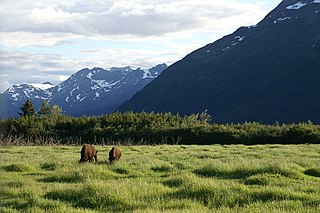
Anchorage, officially the Municipality of Anchorage, is the most populous city in the U.S. state of Alaska. With a population of 291,247 at the 2020 census, it contains nearly 40 percent of the state's population. The Anchorage metropolitan area, which includes Anchorage and the neighboring Matanuska-Susitna Borough, had a population of 398,328 in 2020, accounting for more than half the state's population. At 1,706 sq mi (4,420 km2) of land area, the city is the fourth-largest by area in the U.S.
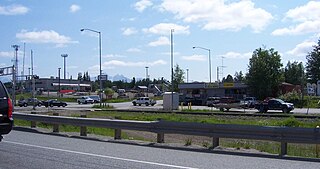
The City of Wasilla (Dena'ina: Benteh) is a city in Matanuska-Susitna Borough, United States and the fourth-largest city in Alaska. It is located on the northern point of Cook Inlet in the Matanuska-Susitna Valley of the southcentral part of the state. The city's population was 9,054 at the 2020 census, up from 7,831 in 2010. Wasilla is the largest city in the borough and a part of the Anchorage metropolitan area, which had an estimated population of 398,328 in 2020.
This article is a timeline of the history of the city of Boston, Massachusetts, USA.

The Alaska Anchorage Seawolves men's ice hockey team is a National Collegiate Athletic Association (NCAA) Division I college ice hockey program that represents the University of Alaska Anchorage. The Seawolves were an original member of the now defunct men's division in the Western Collegiate Hockey Association (WCHA). They played at the Sullivan Arena in Anchorage, Alaska, and moved to the Seawolf Sports Complex on campus at the start of the 2019–20 season.

Matanuska-Susitna Valley is an area in Southcentral Alaska south of the Alaska Range about 35 miles (56 km) north of Anchorage, Alaska. It is known for the world record sized cabbages and other vegetables displayed annually in Palmer at the Alaska State Fair. It includes the valleys of the Matanuska, Knik, and Susitna Rivers. 11,000 of Mat-Su Valley residents commute to Anchorage for work . It is the fastest growing region in Alaska and includes the towns of Palmer, Wasilla, Big Lake, Houston, Willow, Sutton, and Talkeetna. The Matanuska-Susitna Valley is primarily the land of the Dena'ina and Ahtna Athabaskan people.
The following is a timeline of the history of the city of Hartford, Connecticut, USA.
The following is a timeline of the history of the city of Seattle, Washington, USA.
The following is a timeline of the history of the city of Austin, Texas, USA.
The following is a timeline of the history of the city of St. Louis, Missouri, United States.
The following is a timeline of the history of the city of Fargo, North Dakota, USA.
The following is a timeline of the history of the city of Ciudad Juárez, Chihuahua, Mexico.
The following is a timeline of the history of the city of Toledo, Ohio, USA.
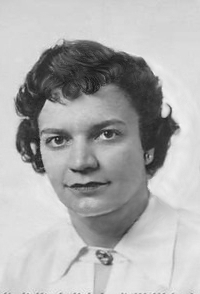
Ruth Anna Marie Schmidt was an American geologist and paleontologist who was a pioneer for women scientists. She spent most of her career in Alaska, where she established a United States Geological Survey (USGS) field office and established the first Department of Geology at the Anchorage Community College, now part of the University of Alaska Anchorage. In 1964, Schmidt directed the initial assessment of the damage done to the city of Anchorage by the Great Alaska Earthquake, the largest earthquake in North American history, and the second largest earthquake ever to be recorded. She worked for the USGS in Washington, DC during the era of McCarthyism and was investigated twice for disloyalty because of her membership in the interracial Washington Cooperative Bookshop. She was cleared both times. She earned a number of awards, honors, and letters of commendation and appreciation. After her death in 2014, she was recognized as a philanthropist.
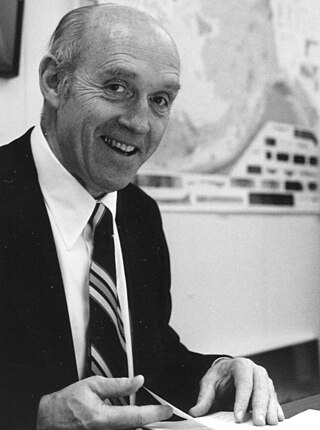
John R. Roderick was an American lawyer and politician who served as the mayor of Anchorage, Alaska from 1972 to 1975.